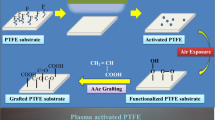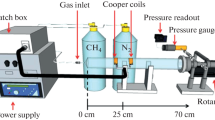Abstract
Non-equilibrium solution plasma treatment of polymer surfaces in water offers the possibility of more dense and selective polymer surface functionalization in comparison to the well-known and frequently used low-pressure oxygen plasma. Functional groups are introduced when the polymer surface contacts the plasma moderated solution especially water solutions. The emission of ions, electrons, energy-rich neutrals and complexes, produced by the ion avalanche are limited by quenching, with the aid of the ambient water phase. The UV-radiation produced in plasma formation also helps to moderate the reaction solution further by producing additional excited, ionized/dissociated molecules. Thus, monotype functional groups equipped polymer surfaces, preferably OH groups, originating from the dissociated water molecules, could be produced more selectively. An interesting feature of the technique is its flexibility to use a wide variety of additives in the water phase. Another way to modify polymer surfaces is the deposition of plasma polymers carrying functional groups as carboxylic groups used in this work. Acetic acid, acrylic acid, maleic and itaconic acid were used as additive monomers. Acetic acid is not a chemically polymerizing monomer but it could polymerize by monomer/molecular fragmentation and recombination to a cross linked layer. The other monomers form preferably water-soluble polymers on a chemical way. Only the fragmented fraction of these monomers could form an insoluble coating by cross linking to substrate. The XPS analysis was used to track the alterations in –O-CO- bond percentage on the PP surface. To identify the -COOH groups on substrate surface unambiguously, which have survived the plasma polymerization process, the derivatization with trifluoroethanol was performed.
Similar content being viewed by others
References
K. Rossmann, J. Polym. Sci. 19, 141 (1956)
N. Inagaki, Plasma surface modification and plasma polymerization (Technomic Publication, Lancaster, Pennsylvania, 1996)
G. Kühn, S. Weidner, R. Decker, A. Ghode, J. Friedrich, Surf. Coat. Technol. 116–119, 796 (1999)
C. Oehr, M. Müller, B. Elkin, D. Hegemann, U. Vohrer, Surf. Coat. Technol. 116, 25 (1999)
I. Koprinarov, A. Lippitz, J.F. Friedrich, W.E.S. Unger, Ch. Wöll, Polymer 39, 3001 (1998)
S. Wettmarshausen, H.-U. Mittmann, G. Kühn, G. Hidde, J.F. Friedrich, Plasma Proc. Polym. 4, 832 (2007)
J. Friedrich, G. Kühn, R. Mix, Prog. Colloid Polym. Sci. 132, 62 (2006)
M. Noeske, J. Degenhardt, S. Strudthoff, U. Lommatzsch, Int. J. Adhes. Adhes. 24, 171 (2004)
J. Friedrich, R. Mix, G. Kühn, W. Unger, Plasma Proc. Polym. 1, 28 (2004)
R. d’Agostino, P. Favia, C. Oehr, M.R. Wertheimer (Wiley-VCH, Weinheim, Switzerland, 2005) pp. 3–21
R. Joshi, R.-D. Schulze, A. Meyer-Plath, J. Friedrich, Plasma Proc. Polym. 5, 695 (2008)
J. Friedrich, W. Unger, A. Lippitz, I. Koprinarov, A. Ghode, Sh. Geng, G. Kühn, Composite Interface 10, 139 (2003)
E. Kokufuta, T. Sodeyama, K. Fujimori, K. Harada, L. Nakamura, J. Chem. Soc., Chem. Commun. 5, 269 (1984)
E. Kokufuta, T. Shibasaki, T. Sodeyama, K. Harada, Chem. Lett. 14, 10, 1569 (1985)
G. Beamson, D. Briggs, High Resolution XPS of Organic Polymers (John Wiley & Sons, Chichester, 1992)
M.R. Alexander, P.V. Wright, B.D. Ratner, Surf. Interf. Anal. 24, 217 (1996)
M. Sato, T. Ohgiyama, J. Clements, IEEE Trans. Ind. Appl. 32, 106 (1996)
G. Jinzhang, W. Aixiang, F. Yan, W. Jianlin, M Dongping, G. Xiao, L. Yan, Y. Wu, Plasma Sci. Technol. 10, 30 (2008)
B. Tate, Die Makromoleculare Chemie 109, 176 (1967)
G. Kühn, I. Retzko, A. Lippitz, W. Unger, J. Friedrich, Surf. Coat. Technol. 142–144, 494 (2001)
A. Nikiforov, C. Leys, Plasma Chem. Plasma Process. 26, 415 (2006)
Hans-Georg, Elias, Makromoleküle, Vol. 1 (Huthig & Wepf, 1990)
Author information
Authors and Affiliations
Corresponding author
Rights and permissions
About this article
Cite this article
Joshi, R., Friedrich, J. & Wagner, M. Study of carboxylic functionalization of polypropylene surface using the underwater plasma technique. Eur. Phys. J. D 54, 249–258 (2009). https://doi.org/10.1140/epjd/e2009-00088-6
Received:
Revised:
Published:
Issue Date:
DOI: https://doi.org/10.1140/epjd/e2009-00088-6




